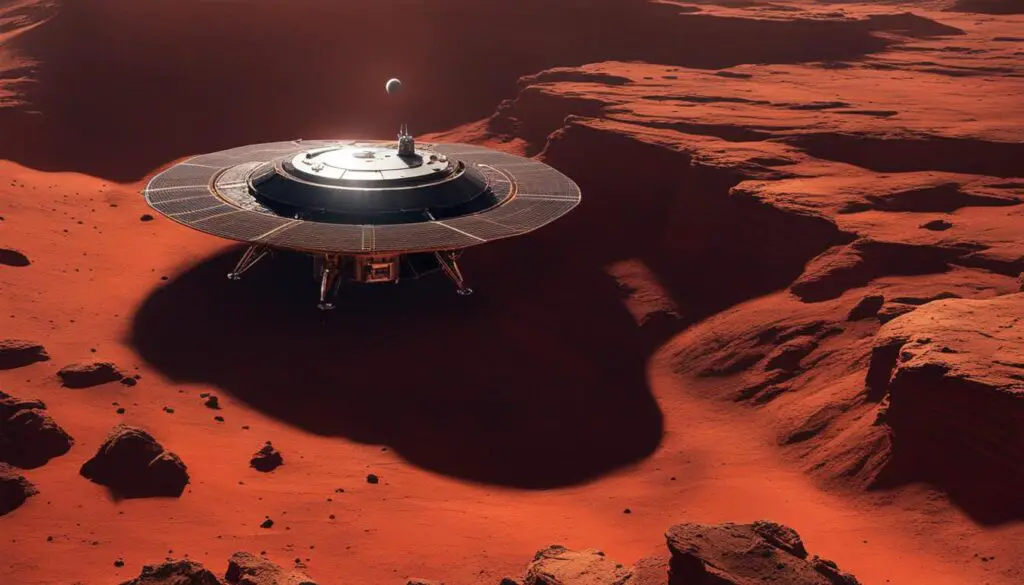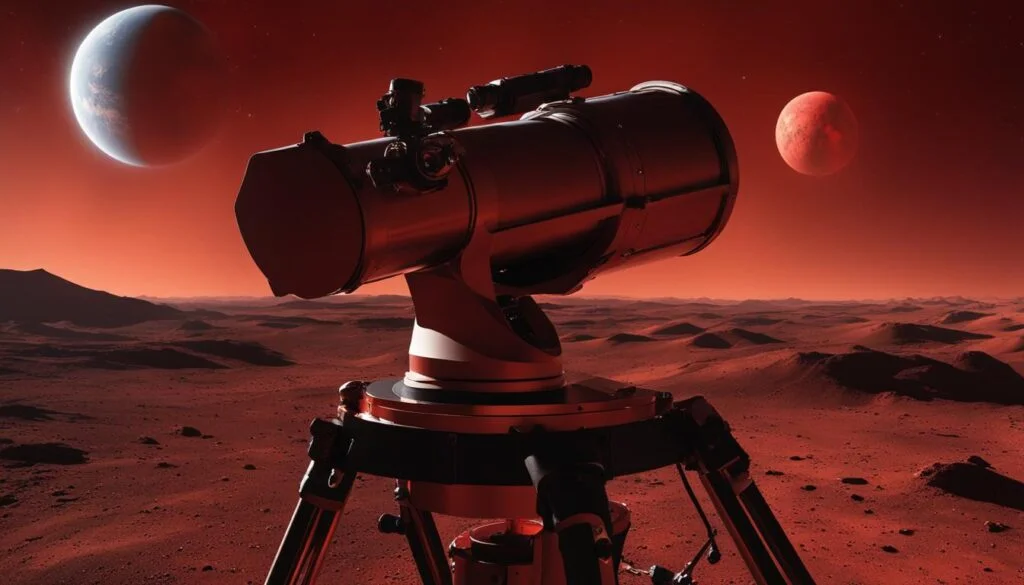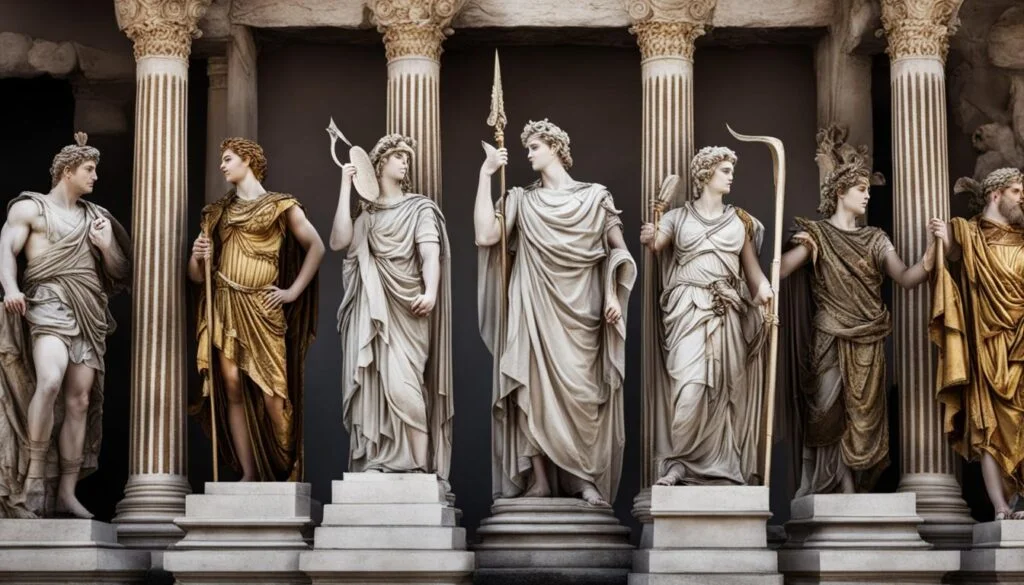Welcome to our exciting journey into the world of Roman mythology, where we uncover the fascinating stories and exploits of the Roman god Mars. Known as the god of war, Mars held a significant role in ancient Rome, not only in matters of military prowess but also in matters of religious significance. Join us as we explore the captivating tales surrounding Mars in Roman mythology and delve into the depths of his activities in the ancient city.
Key Takeaways:
- The Roman god Mars played a crucial role in Roman mythology and religion.
- Mars was closely associated with military prowess and agriculture.
- Mars and Venus’ scandalous affair showcases the complexities of love and betrayal.
- Mars’ connection to the foundation of Rome is evident in the construction of the Temple of Mars Ultor.
- Authors like Edgar Rice Burroughs and H.G. Wells have depicted Mars in literature and fantasy.
Mars and Venus: A Scandalous Affair
One of the most famous tales involving Mars in Roman mythology is the story of Mars and Venus caught in a net. This scandalous affair between Mars, the god of war, and Venus, the goddess of love and beauty, showcases the complexities of human emotions and relationships. The story reveals the irresistible attraction between the two gods, and the consequences of their forbidden love. The earliest version of this story can be found in Homer’s Odyssey, where Mars and Venus are exposed by Vulcan, Venus’ husband, after being trapped in a net. The story later appeared in Ovid’s Ars Amatoria and Metamorphoses, further cementing its popularity in Roman mythology.
The legend of Mars and Venus caught in a net is a popular theme in art and literature, as it explores themes of desire, betrayal, and the consequences of forbidden love. The British Museum’s Greek and Roman collection features various artworks depicting this scandalous affair. These artworks provide visual representations of the story and offer insights into the ancient Romans’ fascination with love and mythology.
Through the tale of Mars and Venus, we gain a glimpse into the complexities of human relationships and the powerful emotions that drive our actions. This myth serves as a reminder that even the gods are not immune to the frailties of the heart, and that love can often lead to unexpected consequences.
The Scandalous Affair of Mars and Venus:
- Mars, the Roman god of war, and Venus, the goddess of love and beauty, engage in a forbidden love affair.
- They are caught in a net by Vulcan, Venus’ husband, who exposes their secret.
- The story appears in Homer’s Odyssey, Ovid’s Ars Amatoria, and Metamorphoses, among other ancient texts.
- Artworks in the British Museum’s Greek and Roman collection depict the scandalous affair.
- The tale explores themes of desire, betrayal, and the consequences of forbidden love.
Mars and the Foundation of Rome

In Roman mythology, Mars played a crucial role in the foundation of Rome. According to legend, Rome was founded by Romulus and Remus, who were believed to be the sons of Mars and a mortal princess. This connection between Mars and Rome highlights the importance of warfare and conquest in the city’s early history.
To honor Mars and commemorate Rome’s military might, Emperor Augustus built the Temple of Mars Ultor (the Avenger). This grand temple served as a sacred space for worship and a symbol of Rome’s divine protection. It was a testament to Mars’ significance in ancient Roman society and his role as the guardian of the city.
The Legend of Romulus and Remus
The story of Romulus and Remus is a central part of Roman mythology and the foundation of Rome. According to legend, the twins were abandoned at birth and raised by a she-wolf. As they grew older, they decided to build a city on the site where they had been rescued. However, a dispute arose between the brothers over who would rule the new city.
Legend has it that Remus mocked the low walls his brother had built, so Romulus became enraged and killed him. With Remus’ death, Romulus became the sole ruler of the city, which he named Rome after himself. This tale of ambition, fratricide, and divine parentage illustrates the complex origins of one of history’s most powerful empires.
The Temple of Mars Ultor
Emperor Augustus, who wanted to honor the memory of his adoptive father Julius Caesar, constructed the Temple of Mars Ultor on the Capitoline Hill in Rome. The temple was dedicated to Mars in his role as the Avenger, seeking retribution for Caesar’s assassination. It became a significant religious and political center, hosting ceremonies, rituals, and processions.
The Temple of Mars Ultor stood as a symbol of Rome’s military prowess and the divine protection granted by Mars. Its grandeur and prominence reflected the city’s status as a dominant force in the ancient world. Though the temple no longer stands today, its legacy and the mythological connection between Mars and Rome continue to fascinate and inspire.
Mars in Literature and Fantasy

Mars has long served as a captivating subject in literature and fantasy, captivating the imaginations of readers and transporting them to thrilling new worlds.
The Martian Adventures of Edgar Rice Burroughs
One notable example is Edgar Rice Burroughs’ novel A Princess of Mars, which takes readers on a thrilling journey to the red planet. Published in 1912, this tale follows the adventures of John Carter, a Confederate officer who is mysteriously transported to Mars. Burroughs’ vivid descriptions of the Martian landscape and the diverse civilizations that inhabit it have made this novel a beloved classic in the realm of Martian literature.
Mars as the Setting of Intergalactic Wars in “War of the Worlds”
Another iconic work featuring Mars is H.G. Wells’ science fiction novel War of the Worlds. In this gripping tale, Martian invaders launch a destructive attack on Earth, setting the stage for an epic battle for survival. Published in 1897, Wells’ novel explores humanity’s struggle against a technologically advanced alien civilization and raises thought-provoking questions about our place in the universe.
- Mars in fantasy literature has sparked the imagination of readers for over a century
- Edgar Rice Burroughs’ A Princess of Mars transports readers to an exciting world of adventure and intrigue
- H.G. Wells’ War of the Worlds paints a vivid picture of a Martian invasion and its repercussions on Earth
These works of literature showcase the versatility of Mars as a backdrop for thrilling tales of adventure, exploration, and conflict. They continue to inspire writers and readers alike, keeping the allure of the red planet alive in the realm of fantasy and science fiction.
Mars in Popular Culture

Mars, the “Red Planet,” has not only fascinated scientists and space enthusiasts but has also made a significant impact on popular culture. From exploration to movies and music, Mars has become a symbol of curiosity and discovery.
The Exploration of Mars
The exploration of Mars has been a monumental endeavor for space agencies, particularly NASA. Rovers like Opportunity and Curiosity have been sent to Mars to gather valuable data about the planet’s geology, atmosphere, and potential for life. These robotic explorers have provided us with breathtaking images and groundbreaking scientific insights, sparking our imagination about the mysteries of Mars.
Mars in Movies and Music
Mars has been a popular theme in movies and music, captivating audiences with its otherworldly allure. Films like “The Martian” and “Total Recall” have transported us to the planet’s surface, showcasing its harsh and fascinating landscapes. Additionally, musicians have been inspired by Mars, with songs like David Bowie’s “Life on Mars?” and Bruno Mars’ “Talking to the Moon” evoking the planet’s mystique and symbolism.
Popularizing the “Red Planet”
- Mars exploration has fueled our fascination with the unknown, encouraging us to push the boundaries of our understanding.
- Movies and music featuring Mars have allowed us to envision otherworldly adventures and contemplate our place in the universe.
- The popularity of Mars in popular culture reflects our deep-seated curiosity and desire to explore the cosmos.
As we continue to learn more about Mars through scientific research and technological advancements, its presence in popular culture serves as a constant reminder of our enduring fascination with the mysteries of the universe.
Mars in Scientific Research

Scientific research on Mars has opened up new avenues of understanding about the red planet. One of the key areas of focus is the exploration of Mars’ atmosphere. Scientists have been studying the composition and dynamics of the Martian atmosphere to gain insights into its past conditions and potential habitability. By analyzing data from NASA’s HiRise program, which provides high-resolution images of Mars, researchers have been able to study the planet’s atmospheric features in detail. This research brings us closer to unraveling the mysteries of Mars’ past and its potential as a habitable planet.
Key Points:
- Mars research has focused on studying the planet’s atmosphere.
- NASA’s HiRise program provides high-resolution images for detailed analysis.
- Scientists aim to understand Mars’ past conditions and potential for supporting life.
Another important aspect of Mars research is the investigation of its potential habitability. Scientists have been examining Martian meteorites and conducting experiments to determine if Mars could have supported life in the past. By analyzing rocks from Earth’s early period, scientists can draw comparisons to the conditions on Mars and assess its habitability. These research efforts have provided valuable insights into the unique characteristics of Mars as a planet and its potential for hosting life.
Through ongoing scientific research, we continue to deepen our understanding of Mars and its place in the universe. The exploration of Mars’ atmosphere, the investigation of its habitability, and the analysis of Martian meteorites all contribute to our knowledge of this fascinating planet. As technology advances and our research capabilities improve, we can expect to uncover even more secrets about Mars and potentially find answers to the enduring question of whether life exists beyond Earth.
Mars: A Celestial Delight

Mars, the “Red Planet,” offers celestial enthusiasts a thrilling opportunity to observe its beauty in the night sky. During certain times of the year, when Mars is at opposition to the sun, the planet becomes more visible, creating a captivating astronomical event for stargazers. This celestial delight allows us to appreciate the wonder and beauty of the universe.
Stargazing enthusiasts can mark their calendars for the period surrounding April 8, when Mars reaches opposition. This means that Mars, Earth, and the sun are aligned in a straight line, with Earth positioned between Mars and the sun. During this time, Mars appears brighter in the southeastern sky and is more easily visible to the naked eye. For those with telescopes, observing Mars during opposition provides an opportunity to witness its distinct red glow and potentially glimpse some of its surface features.
Why stargazers love observing Mars:
- Mars’ distinctive red color: The planet’s reddish hue is caused by iron oxide, giving it a unique and striking appearance.
- Surface features: Observing Mars through a telescope reveals various surface features, including polar ice caps, dark volcanic plains, and even the occasional dust storm.
- Planetary exploration: Observing Mars connects us to ongoing missions and scientific exploration, such as NASA’s Perseverance rover, providing a deeper understanding of this neighboring planet.
So, if you’re an avid stargazer or simply someone who appreciates the marvels of the night sky, make sure to take advantage of the opportunity to observe Mars during its opposition. It’s a chance to witness the beauty of our celestial neighbor and marvel at the wonders of the universe.
Conclusion
Mars, a celestial object that has fascinated humans for centuries, holds a unique place in both myth and reality. In Roman mythology, the tales and exploits of Mars offer us a glimpse into the complexities of human nature, highlighting the significance of war and agriculture in ancient society. The scandalous affair between Mars and Venus showcases the intricate dynamics of love and betrayal, while Mars’ role in the foundation of Rome signifies the divine connection between the god of war and the mighty empire.
On the other hand, scientific research has allowed us to explore Mars in a new light, unravelling the mysteries of its past and present. The high-resolution imaging provided by NASA’s HiRise program has granted us breathtaking views of the Martian surface, while the study of Martian meteorites and Earth’s ancient rocks has provided valuable insights into Mars’ atmospheric evolution and potential habitability. These scientific endeavors have ignited our imagination and curiosity, fueling our fascination with the possibility of life on Mars.
Beyond mythology and scientific research, Mars continues to captivate us as a celestial delight. Stargazers eagerly await Mars’ opposition to the sun, when the planet becomes more visible in the night sky. Its distinct red glow and surface features offer a mesmerizing sight for those with telescopes, reminding us of the vast wonders and beauty of the universe.
In conclusion, Mars, whether in myth or reality, has left an indelible mark on human history and imagination. From the ancient tales of Roman mythology to the groundbreaking scientific discoveries of today, Mars continues to fascinate us as a symbol of human curiosity, exploration, and the possibilities that lie beyond our home planet.
FAQ
Who is Mars in Roman mythology?
Mars is the Roman god of war and agriculture.
What is the story of Mars and Venus caught in a net?
The story involves Mars and Venus being exposed by Vulcan, Venus’ husband, and explores themes of love, passion, and betrayal.
What role did Mars play in the foundation of Rome?
Mars was believed to be the father of Romulus, the founder of Rome, and a temple dedicated to Mars Ultor was constructed by Emperor Augustus to symbolize Rome’s military might.
How has Mars been depicted in literature and fantasy?
Mars has been portrayed as a mysterious and fantastical world in works like Edgar Rice Burroughs’ “A Princess of Mars” and H.G. Wells’ “War of the Worlds.”
How does Mars captivate modern audiences?
Mars is explored by NASA’s rovers, has been featured in movies and music, and continues to fascinate us with its potential for life and exploration.
What scientific research is being conducted on Mars?
NASA’s HiRise program provides high-resolution images of Mars, scientists study Martian meteorites and rocks to understand its past habitability, and more.
Can I observe Mars in the night sky?
Yes, during the period surrounding April 8th, Mars is more visible in the southeastern sky, and stargazers with telescopes can appreciate its distinct red glow and surface features.
What is the fascination with Mars?
Mars, both in mythology and scientific exploration, captivates humans with its tales, potential for life, and as a symbol of human curiosity and exploration.




